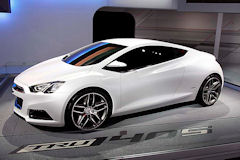
Chevy's concept car, the Tru-140S, is designed to stimulate the interest of 20-something Millennials. But Millennials are diffident about owning cars at all.
Back when the Baby Boomers were coming of age a zillion years ago, the Detroit automakers had a problem: Boomers rejected their parents’ favored American brands and embraced cars from Japan and Germany. Today, automakers of all nationalities have an even bigger problem. Members of the Millennial generation are rejecting their Boomer parents’ preference for automobiles in the first place.
An article in today’s New York Times suggests the scope of the challenge:
In 2008, 46.3 percent of potential drivers 19 years old and younger had drivers’ licenses, compared with 64.4 percent in 1998, according to the Federal Highway Administration, and drivers ages 21 to 30 drove 12 percent fewer miles in 2009 than they did in 1995.
Forty-six percent of drivers aged 18 to 24 said they would choose Internet access over owning a car, according to the research firm Gartner.
Cars are still essential to drivers of all ages, and car cultures still endure in swaths of suburban and rural areas. But automobiles have fallen in the public estimation of younger people. In a survey of 3,000 consumers born from 1981 to 2000 — a generation marketers call “millennials”— [brand consultant] Scratch asked which of 31 brands they preferred. Not one car brand ranked in the top 10, lagging far behind companies like Google and Nike.
Given how indispensable cars are to function in our society, those numbers are extraordinary.
This isn’t a problem that affects only Detroit. Here in Virginia, developers, home builders and municipal planners need to anticipate Millennials’ preferences by designing the kinds of places where young people prefer to live. For many, that means building communities where it is possible to pursue a “car-free” lifestyle. Local officials and their planning staffs need to revisit comprehensive plans built around the preferences of Boomers like themselves. At the very least, they need to loosen the cosseted restrictions of their comprehensive plans and zoning codes to allow developers more leeway to innovate.
Finally, state officials need to re-think their financial priorities for transportation funding. If young people are more likely than their parents to live in densely urbanized areas with greater access to mass transit, bike lanes and other transportation alternatives, should the commonwealth still be building roads into the suburban frontier? And if the younger generation prefers mass transit and other forms of shared ridership, should state officials not be straining to make commuter rail more economically viable rather than the expensive, money-losing fiscal disaster that it currently is?
We can see the changes coming. Shame on us for continuing Business As Usual.
— JAB


